If you're new here, you may want to subscribe to my RSS feed. Thanks for visiting!
(NOTE: Air Guns are NOT toys. When used improperly, an air gun can cause serious bodily harm or even death. Treat with proper respect and safety as one would of any firearm. Remember and practice the rules of firearm safety at all times.)
Recently, I have read more than a few people talking about the availability of ammunition or lack thereof and the ubiquitous training round, the .22LR rim fire.
For your consideration: Air rifles/pistols.
Air rifles and pistols exercise all the same fundamentals of marksmanship, just at shorter ranges and can even be used for hunting. In light of more than a few ranges being closed due to COVID-19, a number of air guns are backyard friendly. No hearing protection required, but as always, eye protection. Your neighbor will not even be aware you are shooting.
But safety first! You are responsible for every shot taken. Know where the pellet is going to go. Have a backstop with sufficient stopping power.
RELATED: Selco’s Principles of Successful Makeshift Weapons When You Don’t (or Can’t) Have a Gun
Air rifle and pistol types
The Break Barrel – The barrel is used to compress either a coiled spring or a gas spring. The effort to compress the piston can vary from easy to requiring a degree of strength. Some manufactures will list this effort, called “cocking effort,” in pounds. The pellet is loaded and then the barrel is returned to the firing position. When the trigger is squeezed, the spring is released, drives a piston into a compression chamber and the air is then forced into a transfer port to the barrel and sending the pellet down range.

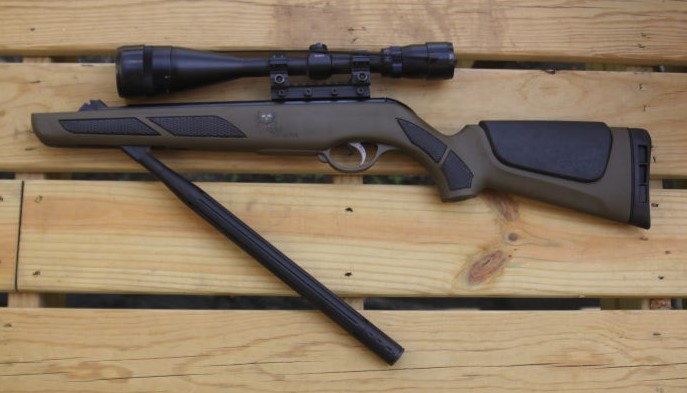
There are variations called a Underlever. The barrel is fixed, and a lever is located under the barrel that compresses the piston. Most are single shot, requiring a manual reload after every shot, but there are newer multi-shot break barrel air rifles out there.
One note about these types of air guns is you will need a spring or gas piston rated scope if you choose to use one. The recoil action of the piston is different from a regular firearm. While the recoil is NOT substantial, a scope not rated for air use, will not last long (i.e. they get wrecked).
Single Stroke Pneumatic – A lever is used to force air into a set volume reservoir, generally very small. When the trigger is squeezed, the air from the reservoir is released into the barrel and sending the pellet on its way. Generally these are lower powered pellet rifles or pistols, more common in economic target shooting or plinking. Some of the heavier single strokes can be used for short ranged hunting, less than 30 yards for a humane kill, with proper shot placement.
Usually single shot.
Below is a Russian made IZH46M . It is an entry level .177 caliber 10 meter target pistol. When I bought it new in 2003 it was going for about $400. Now, with the sanctions against Russia, even a used one is going for about $600.
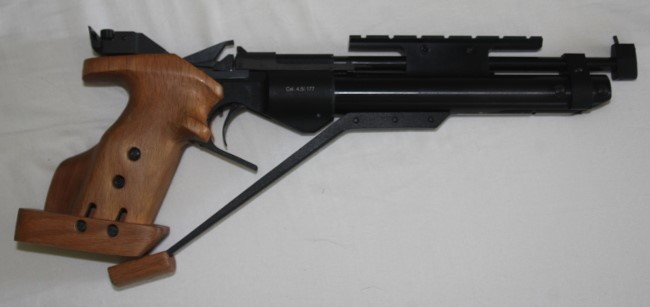
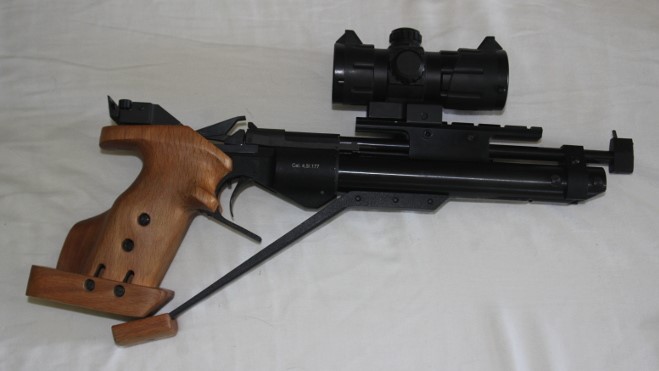
The trigger and the sights are excellent. There is no safety, as you are the safety. There is nearly no recoil. I put a mount on it so I could also use a red dot with it. It is very accurate, more so than I.
Multi-Stroke Pneumatic – Similar to the Single Stroke Pneumatic, but with the variability of multi-pumps for increased power over a single stroke.
Below is a Crosman 1377, multi-stroke pneumatic pistol. The trigger is surprisingly decent, but the sights are bloody awful. Once you get used to the Point Of Aim (POA) vs Point Of Impact (POI), the sights are just “okay.” It is cheap and fun for plinking.
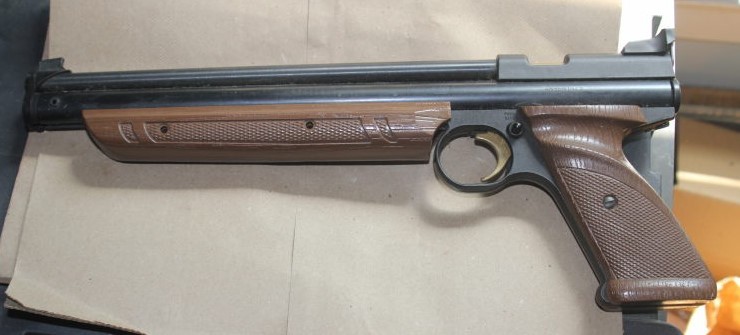
A carbon dioxide (CO2) is powered by a cartridge containing a set amount of CO2 gas in 12-gram, 88-gram or 90-gram cartridges. Most (but not all) are pistols, with some CO2 rifles that can take 2 cartridges or larger ones, with a few duel “fuel” (air or CO2) rifles out there. The CO2 cartridge has a limited shot count that varies from air gun to air gun and the weight of the pellet used. As more shots are taken, more CO2 used up, eventually the Point of Aim vs the Point of Impact will diverge, the shots will fall short of the Point of Aim and a new cartridge will have to be installed.
One advantage of CO2 is a number of actual firearms manufactures have licensed their center fired pistols with CO2 replicas. These CO2 pistols are identical to their center fire big brothers in weight, and feel with the same fire controls in the same places. Some even have a “blowback” feature that mimics the cycling of the action of a center fire pistol.
Many people use these as a cheap and convenient training tool from drawing from their actual center fire pistol hostler. At shorter ranges a BB CO2 generally does not have much difference from a rifled pellet CO2. At extended ranges is where the differences will appear. I have seen some reviews of these replicas in the negative sense as the sights can be off and there is no way to adjust them.
There are some target CO2 pistols. They have rifled barrels, better sights, better triggers and most get 50-60 shots per CO2 cartridge with consistent speed of the pellet, meaning better precision. Naturally they cost more.
A single 12-gram CO2 cartridge costs about a dollar a cartridge, but buying in bulk will get the price down to about $0.43 per cartridge for 500 count box ($219.99).
Pre-Charged Pneumatic (aka PCP, not the illegal drug) – These are rifles and pistols that have a on-board air reservoir that can be filled with a special air compressor, a Self Contained Breathing Apparatus (the tanks Fire Fighters use for air), Self Contained Underwater Breathing Apparatus (the tanks SCUBA divers use), or a special high pressure hand pump (looks like a bicycle pump). Those are additional costs that have to be factored into the over all cost.
Depending on the caliber, weight of the pellet, volume of the air reservoir, will affect how many shots you can get per fill of the air reservoir. A .177 caliber 10 meter Olympic air rifle can get nearly 100 shots per fill. My .22 caliber air rifle will get about 50 shots before needing a refill.
This is my very modified, lots of after market parts, custom paint job, .22 caliber PCP air rifle.
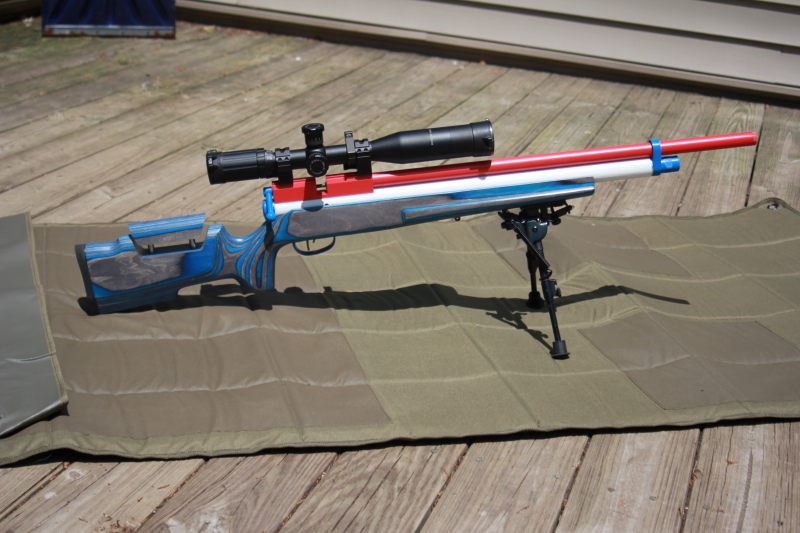
A little back story first: At first, I bought the break barrel rifle in .22 caliber. Added a better scope. Never thought I would ever need anything more than that for simple target shooting, right?
Yeah, not so much.
Two years later, found myself looking at PCP rifles. Talked myself out of and back into the idea of buying one a dozen times over.
I bought a Benjamin Marauder in .22 caliber for about $500, another $200 for the hand pump. Scope was sold separately, but I had other scopes laying around, just needed rings. PCP rifles operate on a different firing mechanism than a Break Barrel with the PCP having nearly no recoil. You can mount any center fire scope on a PCP.
First time I pumped it up, loaded the magazine with ten-pellets, and took a shot off the back deck. It was so quiet, no recoil, I unloaded the magazine, and ran a .22 caliber cleaning rod down the barrel to make sure the pellet was not stuck in the barrel. Nope, it went down range!
Fully adjustable two-stage trigger, this rifle was very, very good. I was getting outstanding groups once I found the right pellet (most air rifles and pistols have a preference for a given pellet). A few years later, we had a rat issue. I got some Crow Magnum pellets (hollow points) and that air rifle, those pellets, a fixed 4x power scope made short work of the rats.
Last year I had the opportunity to modify the Marauder. I put on a Boyds stock, a Hill Air Gun Premium Regulated Matched Parts kit, and a DuraCoat paint job. The Boyds stock just made it a better fit from any shooting position. The Hill Air Gun kit, gave me a regulator which made for a set air usage per shot, for more consistent shots, and more shots per fill (30 shots pre-modified vs 50 post modified).
The paint job is just what I wanted. I like it.
RELATED: The Importance of Silent Self-Defense Weapons in Secluded Places
How much is it going to cost me?
Air guns range in from the very affordable less than $100, to a few thousand dollars. Even .177 Olympic 10 meter air rifles can run into the $3,000 range. With one of those high end rifles and even pistols, Olympic accuracy and precision are there if the shooter can get him or herself there.
Big bore caliber PCP air rifles have made advances in recent years. (.30, .357/9mm, .45 and even .50 caliber are now available. ) Some states are allowing deer hunting with certain calibers of air rifles. But you will only get a few to at most several shots per fill and they are NOT backyard friendly! They will require ear protection. There are more than a few YouTube videos out there of people making serious, consistent, long range shots with a big bore PCP. Not for hunting, but for target.
The price of ammunition can vary, but usually the larger the caliber the higher the cost. You can generally find low end .177 and .22 caliber in the sporting goods section of Wal-Mart or big box sporting goods stores. Match grade .177 or .22, on-line air gun specific sites are best for those and for the big bore pellets, bullets or slugs. For about $60, I can have 2,000 match grade, .22 caliber pellets delivered to my door, no Haz-Mat fee.
And what about maintenance?
Most air rifles are easy to work on (NOTE: render all air guns safe, unloaded and decompressed of all air), and with proper maintenance, can provide years of use.
My IZH46M is still on the original set of o-rings from 2003. After thousands of pellets, I just recently had to replace the o-rings in my Marauder bought in 2014. For $12.75, I got two complete sets of o-rings. A little silicon grease and I am good to go. Some of the more popular air guns have many after market parts. Many air gunners will modify their air guns for more power, for more shot consistency, or accuracy.
In the current shortage of ammunition, or lacking a place to train, an air gun may be a more viable option for training, or maintaining the fundamentals of marksmanship. Some can be both used as for training and for hunting small game very quietly, more so than a suppressed .22LR.
About 1stMarineJarHead
1stMarineJarHead is not only a former Marine, but also a former EMT-B, Wilderness EMT (courtesy of NOLS), and volunteer firefighter.
He currently resides in the great white (i.e. snowy) Northeast with his wife and dogs. He raises chickens, rabbits, goats, occasionally hogs, cows and sometimes ducks. He grows various veggies and has a weird fondness for rutabagas. He enjoys reading, writing, cooking from scratch, making charcuterie, target shooting, and is currently expanding his woodworking skills.

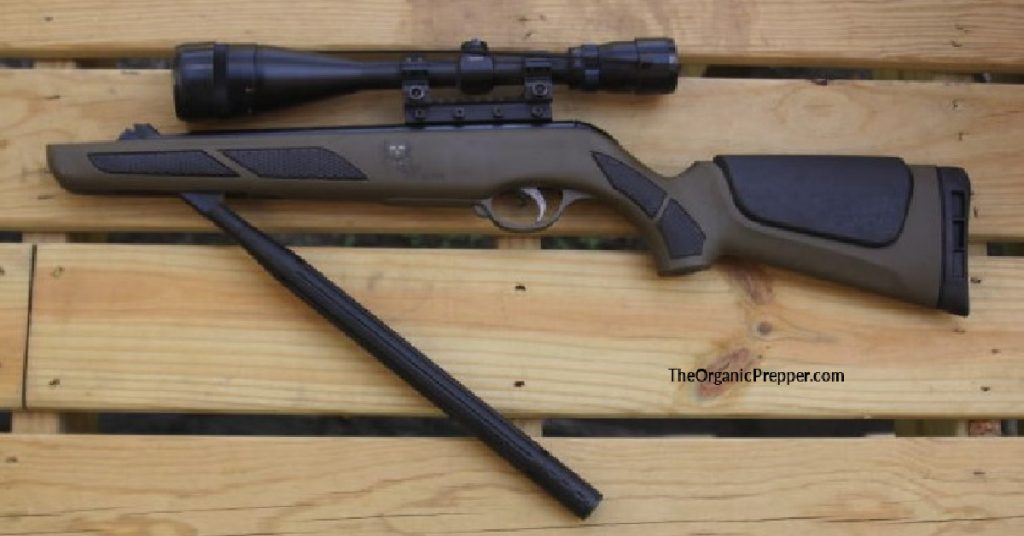















Air rifles have a lot of merit in staying in shooting shape. During the virus lockdown I used an airsoft pistol to stay in handgun shape.
I use air rifle to teach non military how to shoot with a protective gas mask on.
I’ve started teaching both my kids and fixing to start my grandkids soon with one. Targets are printable and a cardboard box can backstop the Red Ryders.
I use a Phillips Pellet Holder on my serious airguns to carry extra ammo.
Howdy Matt in OK.
I use printable targets too, but sometimes reactive targets are more fun.
I have some silhouette knock overs, 1/5 scale. Shoot them out to 100 yards for the Ram.
The break barrel in the pics above, yeah, I use a pellet pen too. Just that much easier.
Considering I just got an e-mail from Cheaper Than Dirt that has 380 ball Winchester white bx 100 count for $150 this probably couldn’t be more timely of an article. I just about choked
Whoa!
I have heard about shortages and increases, but $150 for 100rds of white box?
Here in the UK we use air rifles a lot. Contrary to popular belief, we do have access to firearms, provided we have the correct checks and paperwork, and as long as you are not a convicted felon, it is quite easy.
I use air rifles for hunting rabbits, squirrels and pigeons mainly. The advantages over using one over a shotgun are many. As fields tend to be smaller here, an air rifle is more precise and there is virtually no noise. I would recommend anyone who enjoys shooting sports to try air guns.
A lot of the power ratings can be misleading, most advertised velocities are attained using light weight non lead ammo! and faster is not always best! Accuracy loss is a problem past 1000 fps or so depending on the ammo and gun. I use a .30 cal break barrel air rifle that i cast round ball for, it is advertised at 550 fps with a .44 grain pellet hitting with 34 fpe! on paper that might not sound like much but will punch though both sides of a coconut at thirty yards! leaving a big hole on the backside. As a self contained unit, fairly simple build and cast projectiles, stuff from supply chains is not needed, with a gang mold and the right tools producing the ammo does not require a lot of time or energy. there is a lot of mixed info out there on using round ball in air rifles! and my trick to making it work is a slight over sized ball and short starting them in the breech, and have matched the store bought pellets in accuracy and power! this is what i have done as i am a broke mofo and those pellets are not cheap!!
@Oddhawk,
Good point about listed FPS and actual FPS using lead pellets.
Nearly all PCP, and a number of springers can be “tuned,” i.e. adjusted to increase or decrease the FPS and there by, the energy.
I have my Marauder tuned to an average of 907FPS (38FtLbs) with a 21 grn pellet.
I know a number of guys buying their own molds, casting their own bullets and then shoot into a medium (usually rubber mulch). The captured bullets can then be melted down and recast into new bullets. In theory, they never have to buy ammo again.
Granted, hunting would be a different story.
I would like a recommendation for an air rifle to eliminate flying rats…aka pigeons. They are trashing my place with their waste. But I don’t want my neighbors to hear me shooting. Something not too expensive is preferred.
@Marta,
That is a tough question to answer without knowing particulars.
How are your marksmanship skills?
At what range are you shooting at?
Could you use/cock a break barrel rifle?
How close is your neighbors house or property? Would your shots be taken way from them, or into a good back stop be it the ground, or into the woods?
My marksmanship skill are pretty good but not excellent. Neighbors are around a half acre away. I would be shooting away from their house to an area where the pigeons roost on an I beam of our outbuilding. My kids Daisy BB gun is not effective. Range is about 15-20 yards. I haven’t used that style of break before. But I don’t think it would be an issue. Thank you for your advise.
@Marta,
Thinking on it, if I were in your situation, I would consider a multi-pump, .177 caliber (preferably with a higher FPS, say greater than 700FPS) and use hollow point pellets.
As always, check with your state and local laws concerning hunting.
This site has a map listing most states laws, but local laws may not be listed: https://www.pyramydair.com/airgun-map/
Bravo! (Did not have to read the article to agree, thoroughly, with the premise.)
In the Army in the 70’s we used to use air rifles with M-16 sights retrofitted on them to teach proper sight picture, trigger control. Was useful working with gun shy flinchers to get them past the fear of pulling the trigger. A reduced distance range with reduced sized head and shoulder targets allowed even a decent simulation of 200 yard rifle range shots.
OK, my basic question is this: is there an air rifle that can be used for home defense? I mean, maybe I missed that in the article — and if I did, I cannot apologize enough — but honestly, that’s always been my main concern. Because I have a wife and two young sons to protect, and I have never once been mistaken for being Rambo. So if some doper tries to break in at three am, or I have to deal with some self righteous members of the “coalition of conscience”, I’m gonna go ahead and say that I will NOT be able to break all their spines with the muscles in my smaller toes. I’m not that guy. Never going to be.
Check out Keith Warren Hunting on YouTube. He takes down hogs and some really big game with some models. It comes down to what you want to spend.
I’m getting old and can’t use my small toes to kill anymore I gotta use my elbow these days lol.
An air gun would only be effective as a home defense round if it had sufficient energy to penetrate to the central nervous system (brain) above the cervical spine (neck). In a stressful situation you loose fine motor skills, your hands shake, your adrenaline is up, functionally you lack the ability to shoot well. The statistics of LEO’s in combat show they have a hit rate of less than 20% with auto-loaders, and that only measures their ability to hit a human, not their ability to hit the central nervous system. Functionally an air gun for an untrained person in stress under combat would not be an effective firearm.
If you have to ask if an air gun can be used for home defense, it’s not the right gun for you, go get a shotgun.
If you are ex-military/leo/hunter, a great natural shot and you are a calm person under fire, then an air gun is a viable choice
If you have no other choices, yes get an air gun, but learn how to shoot it really well under all conditions.
@Sammy,
I would not recommend using a air rifle, even big bore, in a self defense situation.
Having said that, only after I have exhausted all other methods of self-defense, thrown everything at my would be assailant to include pots and pans (90% of my pans are cast iron), and forced to use an air rifle, then I might.
I would be more likely to use a percussion black powder pistol first.
To be clear, nope on using an air rifle in a self-defense situation.
The window is closing, even on air rifles.
I went to a local sporting goods store that has a decent firearm section—their ammo shelves were empty. Maybe a total of about five boxes of oddball calibers. They managed to restock the displays behind the counter with pistols and rifles, but with no ammo? They also have a few airguns. (The popular ammo was probably behind the counter, where they could ration it. I didn’t ask.)
I went to the local Walmart—their airgun section now has other camping equipment, only a couple of left-over air rifles but no ammo.
While airguns have and can kill a person, I like others before me do not recommend one as a defensive weapon. The reason I recommend against one is because airguns are so low powered, that they can kill if and only if one hits a vital spot on the body, which are quite small. It’s hard enough to hit one of those spots under optimal conditions, almost impossible in fast moving conditions.
Airguns are useful for taking care of varmints like rats, and target practice.
I have a decent array of shotguns and centre fire rifles but I love my little Crosman Ratcatcher. There’s a modding scene for these CO2 rifles. It’s basically the same as the pistol in this article but with a skeleton stock and a longer barrel.
A £100 rifle that I’ve upgraded with a carbon fibre stock, stainless steel screws, new trigger mech, longer barrel, silencer (it is now silent) etc
It’s still below the UK’s 12ft/lbs limit, although they can be pushed beyond 30ft/lbs and it’s a fun rifle for pigeons and targets under 25 yards.
I bought it as a training rifle for children. Safety catch, single shot, bolt action, light weight. I don’t train these days but there’s no way I’d let it go!
Just FYI: Ammo Shortage May Last Until 2021
https://www.shootingillustrated.com/articles/2020/8/20/ammo-shortage-may-last-until-2021/
The article is date 20 AUG of this year, but in light of the recent election results, the ammo shortage is likely to continue.
I’ve considered adding Air Rifles to our arsenal, but haven’t yet. Since I invested heavily in reloading components prior to the Pandemic, as well as Blackpowder Firearms and Bow and Arrows.
Even though I have enough components on hand to keep us going for a number of years, eventually they will run out. So I need to get serious about looking at other options.
Thank you 1st Marine, for sharing your knowledge and experiences.
Bemused Berserker,
I see air rifles as another tool in the tool box.
Another aspect I look at is training. Say post-SHTF, even .22LR I would be hesitant to dip into my stockpile of that round when I need to train someone marksmanship. Train them to master the fundamentals, then maybe a few rounds of whatever firearm they are going to use i.e. centerfire, or shotgun.